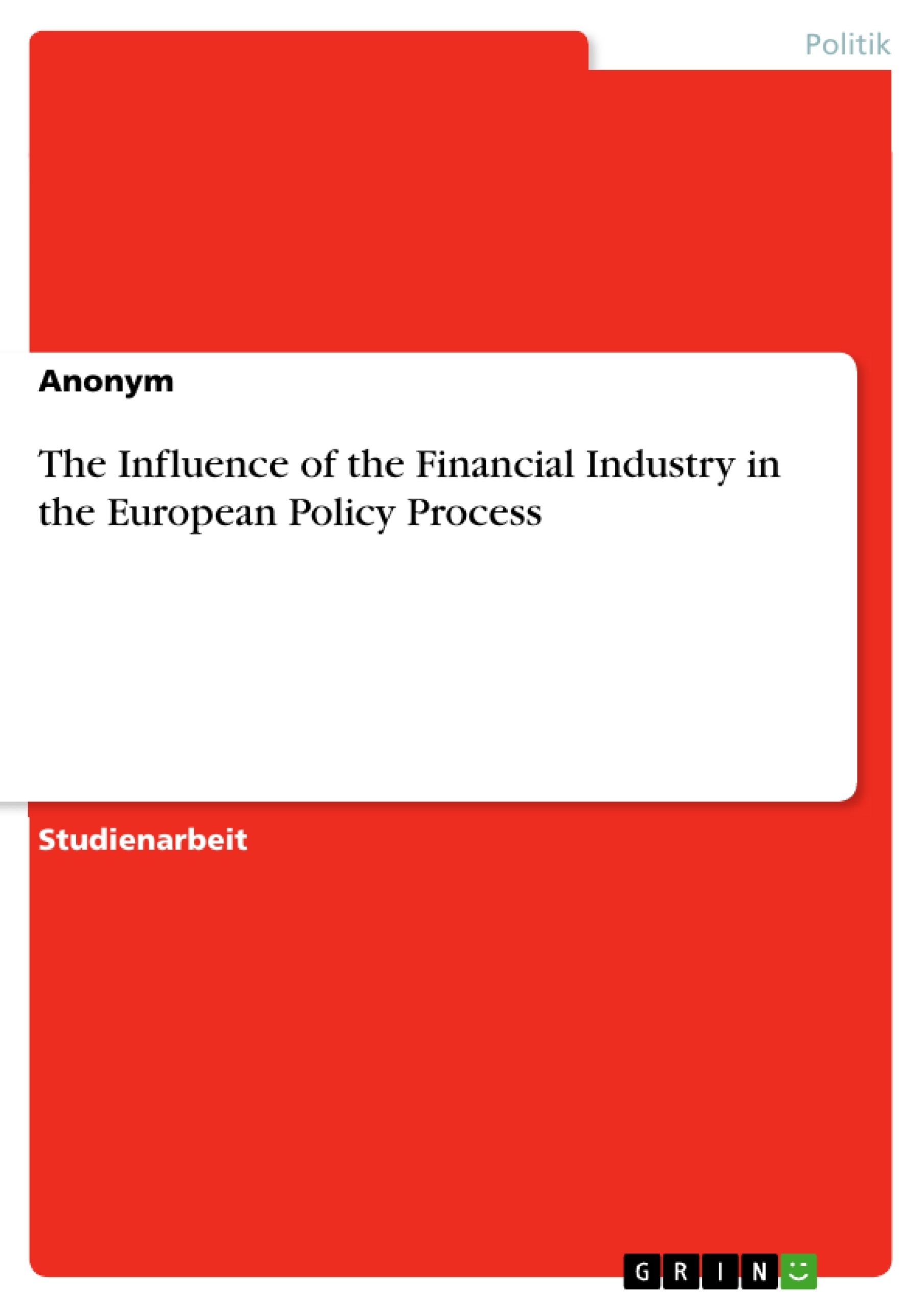At the end of 2005, the European Commission released a white paper on financial service policy (EC 2005: 3). It was called “the best financial framework in the world” (EU Press 2005 found in Stichele 2008: 13). After the Lehman Brothers bankruptcy in September 2008 and the accompanied full break out of the financial crisis, the question on, how such a crisis could occur with the regulation in place, was raised for good reason. Independent experts have warned that the actual lax regulation would lead to a crisis, but according to Haar et al. the Commission preferred to listen to the one-sided advice from the financial industry (2009b: 3).
After the full extent of the crisis and the failures in regulation policy became obvious, one might have expected that new financial regulation would be set up fast. On the G-20 meeting in London in April 2009, Gordon Brown and others proclaimed a counter strike against the financial and economic crisis by. But according to observers, after these confessions, not much has happened in practice due to financial lobby resistance (Zeit 2009). Still in April 2010, the German newspaper Zeit pointed out that the financial industry’s power has prevented new financial regulation.
Although financial lobby influence is certainly not the only reason, why regulatory reform is not getting further, it has a strong influence in the policy process and overshadows other interests. In Europe, it is especially effective: The European market has been continuously liberalized, but supervision did not keep up with this trend. Financial regulation must satisfy the international level but should also be flexible enough to grasp national differences. Moreover countries are played off against each other. When a single country decides to regulate more strictly, companies can always threaten to leave the country (Stichele 2008: 40, 48).
All these considerations give good reason to analyze how the financial industry seeks influence in the European policy process. This paper aims to introduce the different institutional channels where influence can be exercised.
Inhaltsverzeichnis
- 1 Einleitung
- 2 Ein einführender Ansatz zum Einfluss der Finanzwirtschaft
- 2.1 Definition des Wirtschaftsinteresses
- 2.2 Klassifizierung von Lobbying-Taktiken
- 2.3 Die Organisation der Finanzwirtschaftsinteressen auf EU-Ebene
- 3 Der Einfluss der Finanzwirtschaftsinteressen auf die verschiedenen europäischen Gremien
- 3.1 Die europäischen Gremien: Zusammenspiel und Zugänglichkeit
- 3.2 Einflussnahme auf die europäischen Gremien
- 3.2.1 Der Rat der Europäischen Union
- 3.2.2 Das Europäische Parlament
- 3.2.3 Die Europäische Kommission
- 4 Der Einfluss von Expertengruppen
- 5 Folgen und Schlussfolgerung
Zielsetzung und Themenschwerpunkte
Diese Forschungsarbeit untersucht den Einfluss der Finanzwirtschaft auf den europäischen politischen Prozess. Sie analysiert die verschiedenen institutionellen Kanäle, über die Einfluss ausgeübt werden kann, und betrachtet die Organisation der Finanzlobby auf EU-Ebene. Die Arbeit beleuchtet jedoch nicht den empirischen Einfluss der Lobby auf konkrete Entscheidungen oder die spezifischen Inhalte der Regulierungsänderungen.
- Definition und Unterscheidung von Wirtschaftsinteressen
- Klassifizierung von Lobbying-Taktiken und Strategien
- Analyse der Einflussnahme der Finanzlobby auf die europäischen Gremien (Rat, Parlament, Kommission)
- Bedeutung von Expertengruppen und deren Einfluss auf den politischen Prozess
- Folgen des übermäßigen Einflusses der Finanzwirtschaft
Zusammenfassung der Kapitel
Das erste Kapitel liefert eine Einführung in das Thema und beleuchtet den Kontext der Forschungsarbeit. Es werden die Ereignisse rund um die Finanzkrise von 2008 und die Reaktion der europäischen Politik auf die Krise geschildert.
Das zweite Kapitel befasst sich mit dem Einfluss der Finanzwirtschaft und bietet einen analytischen Hintergrund. Es werden Definitionen und Unterscheidungen von Wirtschaftsinteressen sowie Klassifizierungen von Lobbying-Taktiken vorgestellt. Zudem wird die Organisation der Finanzlobby auf EU-Ebene beleuchtet.
Kapitel drei analysiert den Einfluss der Finanzwirtschaftsinteressen auf die verschiedenen europäischen Gremien. Es werden die Interaktionsmuster der Gremien sowie deren Zugänglichkeit betrachtet. Die drei Gremien (Rat, Parlament, Kommission) werden separat untersucht.
Kapitel vier befasst sich mit dem Einfluss von Expertengruppen auf den europäischen politischen Prozess. Es wird gezeigt, wie die Zusammensetzung dieser Gruppen die Dominanz der Finanzwirtschaft gegenüber anderen Interessengruppen widerspiegelt.
Schlüsselwörter
Die Arbeit befasst sich mit dem Einfluss der Finanzindustrie auf den europäischen Politikprozess, den Lobbying-Taktiken der Finanzwirtschaft, der Organisation der Finanzlobby auf EU-Ebene, den institutionellen Kanälen der Einflussnahme, den europäischen Gremien (Rat, Parlament, Kommission) und der Rolle von Expertengruppen.
- Quote paper
- Anonym (Author), 2010, The Influence of the Financial Industry in the European Policy Process , Munich, GRIN Verlag, https://www.grin.com/document/162901



